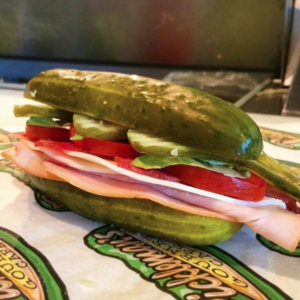This guy downed 32 ounces of pickle juice in 8.34 seconds to become ‘Mayor of Picklesburgh’
The Erie-native competed against four other brine drinkers at the Pittsburgh pickle festival on the Roberto Clemente Bridge.
By ROSSILYNNE CULGAN – The Incline
In one smooth 8.34-second gulp, Fred Smith chugged 32 ounces of pickle juice, winning the brine drinking competition and becoming honorary Mayor of Picklesburgh.
With just a few pickle juice stains on his green “I’m kind of a big dill” T-shirt and his goatee miraculously free of dribbles, Smith said he felt “a lot better than I expected to” after his victory.
He prepared for the competition by chugging beer and Twisted Teas. And, believe it or not, he’s not even a dill devotee.
“They’re all right,” Smith said, when asked if he likes pickles. “I’m not gonna like them for awhile.”
Though he was humble, Smith did seem to be relishing the victory. It’s a pretty big dill after all. (Sorry.)
His ability to even compete in the Saturday night contest was a twist of fate.
Smith traveled to Pittsburgh from his hometown in Erie for the Replay FX Arcade & Gaming Festival. He noticed that the convention was on the same weekend as Picklesburgh, and he wanted to compete in the contest. He showed up Saturday evening and asked if there were any openings. As luck would have it, somebody had just dropped out, creating a spot for him.
“I came in and stole it all,” he said.
Smith brought along his friend (and bartender) Dave Thaler, whose confidence in Smith didn’t wane even after hearing the impressive times his fellow competitors earned in previous rounds.
“I knew he had it,” Thaler said.
“He watched me chug a bunch of teas last night,” Smith added.
The competition was broken into five heats with 10 people in each, then the final showdown pitting the fastest five against each other for the ultimate challenge. Competing alongside Smith were: Eric Baumann, of Oakland; Dan Snyder, of Hazelwood; Davey Allen, of Claysville; and Jason Christian, of East Liverpool, Ohio.
In addition to bragging rights, Smith got $500 cash.
A crowd packed around the stage to watch the showdown.
“The crowd was so into it and cheering. People brought support squads,” said Leigh White, the Pittsburgh Downtown Partnership’s vice president of marketing and communications. “People as far as the eye could see.”
This was the third year for Picklesburgh, a celebration of all things pickled, produced by the Downtown Partnership. Each year, about 75,000 people attend the festival, held on the Roberto Clemente Bridge.
To win the contest, White said, “a love of pickle juice is not enough.”











